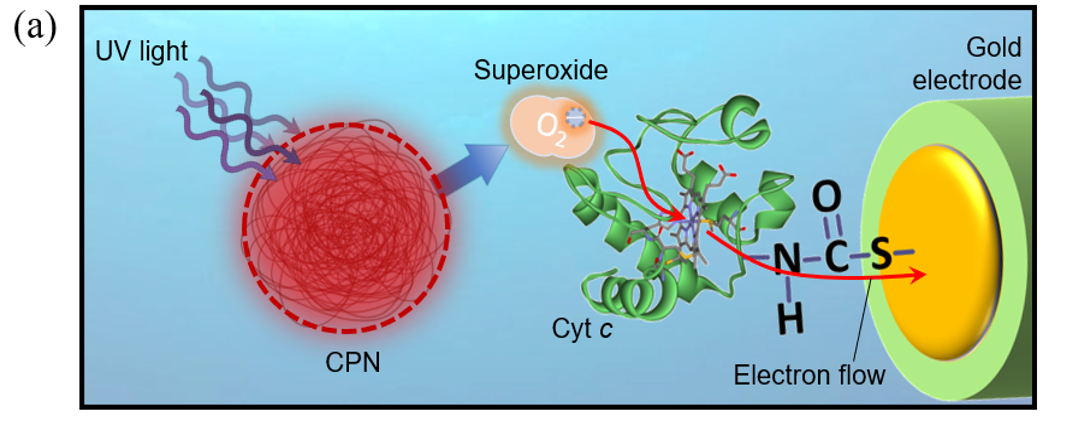Lecture 15: Polymer Nanoparticles
1/28
There's no tags or description
Looks like no tags are added yet.
Name | Mastery | Learn | Test | Matching | Spaced |
|---|
No study sessions yet.
29 Terms
Nanoscale Analysis - Overview
Accurately measuring analytes within living cells in real time is challenging as:
Resolution can be lost due to sensor miniaturisation
Components within the cell (eg proteins) can interfere with measurements
fluorophores
Individual molecular probes (free fluorescent sensing dyes) are physically small enough but usually suffer from chemical interference between probe and cellular components
Fibre-Optic Precursor Technology
Pulled (tapered) fibre optic probes as intracellular sensors
Tip of optical fibres coated with layer of fluorophores or the sensor material was photo-polymerized to the end of the fibre
this probe is inserted through cell membrane
disadvantaged of Fibre-Optic Precursor
Physical size of optical fibres limited the number of probes per cell
Disruption of cell membrane resulted in apoptosis – not ‘passive observations’
only measures small area of cell
types of nanoparticles used as biosensors
The use of polyacrylamide based nanosensors for intracellular imaging and targeted drug delivery (PEBBLEs)
The development of conjugated polymer nanoparticles (CPN) for use in theranostics
Probes Encapsulated By Biologically Localized Embedding (PEBBLEs)
Based on the entrapment of fluorophores in an inert polymer matrix
Matrix protects sensor from cellular matrix (proteins) giving a false +ve and allows cytotoxic reporter molecules to be used
20-200nm radius (1 ppb of cell vol.)
Cell Viability 97% - minimal cell toxicity
Response Time < 1 ms
H+, Ca2+, K+, Na+, Mg2+,Cl-, NO2, O2, NO, Glucose
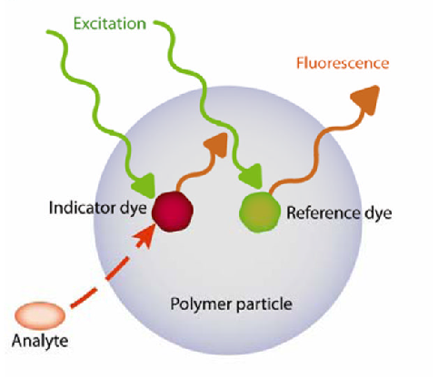
improving PEBBLEs
Indirect detection: if no fluorophore for interested analyte you can embed enzymes into nanoparticle to break down analyte to a product that can be detected
Functionalise surface: can bind Ab on surface to direct to certain parts of cell, localise detection
Manufacturing Materials
PEBBLE polymer structure analogous to ball of rubber bands
Three different matrices are commonly used depending on the sensor materials
Acrylamide
Liquid Polymer
Sol-Gel
PEBBLEs problems
Variations in fluorescence between cells may be caused by:
Uneven fluorescent dye loading?
Fluorophore reacting with analyte of interest?
PEBBLEs are Ratiometric Device
As a first example of a PEBBLE sensor, we take a ratiometric oxygen sensor.
This has a Sol Gel matrix (silica glass) and two different dyes embedded in its core.
The Ruthenium dye (orange) fluorescence is quenched very efficiently in the presence of oxygen, so its intensity goes down with greater local oxygen concentration.
The Oregon Green dye (green) fluorescence is not sensitive to oxygen, so its intensity stays the same and can be used as a reference.
Response & Interference
Oregon Green (OG) can be seen to stay constant
Ruthenium dye (RO) changes its intensity in response to varying amounts of oxygen
Each of these peaks separately changes in intensity due to varying amounts of PEBBLEs present in the solution, or due to changes in the intensity of the excitation light.
But, the ratio of the two peaks does not change with either of these parameters.
So, because each PEBBLE contains both dyes, an internal reference for changes in excitation or PEBBLE concentration is always carried along with each of these nano-devices.
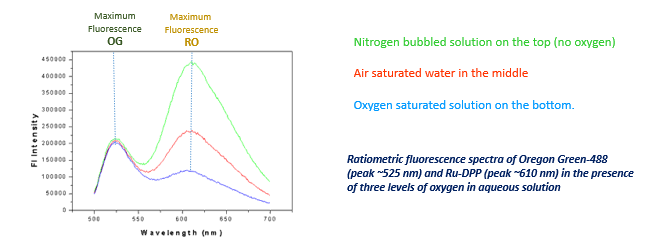
PEBBLEs combat interference
serious problem of free dyes = interference by things like non-specific protein binding
PEBBLE pores too small for proteins to get to fluorophore
This plot shows that the Ru/Oregon Green fluorescence ratio goes up with increasing amounts of Bovine Serum Albumin (BSA) present in the solution
The PEBBLE response stays constant - which is the desired result since the amount of oxygen in solution does not change
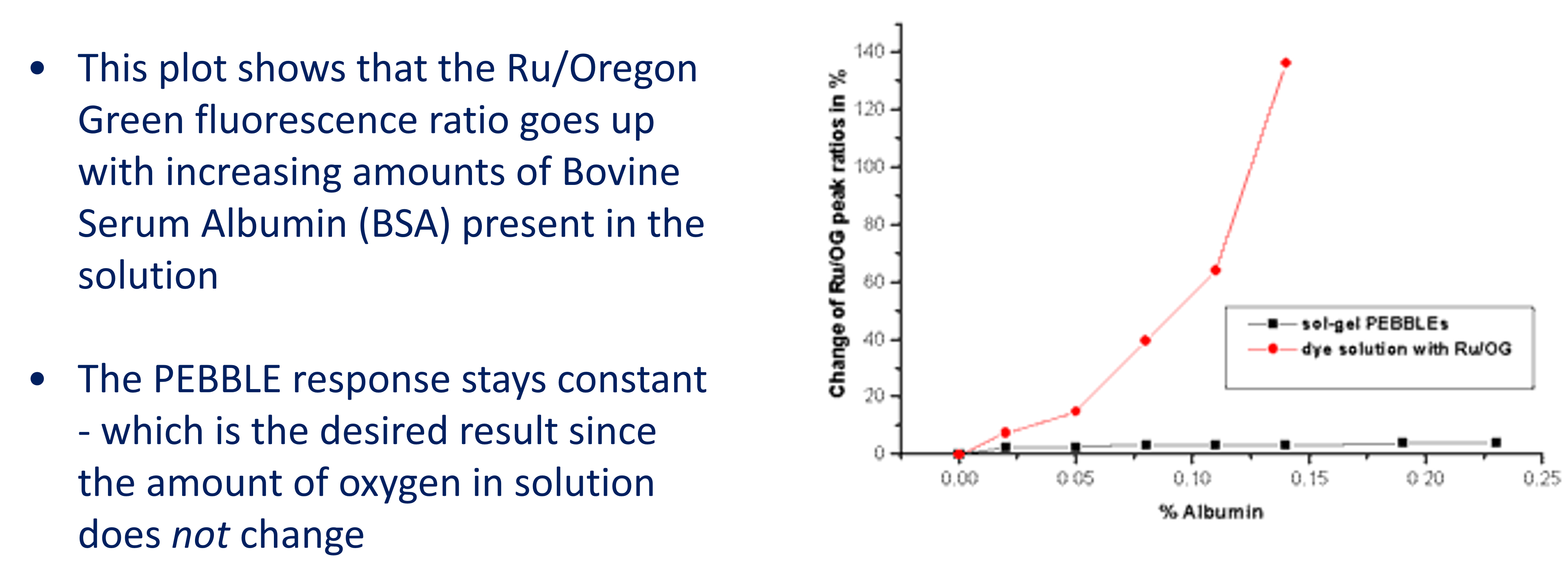
Quantitative Imaging
Oxygen-sensing PEBBLEs have been used for ratiometric fluorescence imaging in rat C6 glioma cells
Computer software used to superimpose the images, showing where signals are coming from within the cells.
Changes in the fluorescence used to show local changes in oxygen concentration
ratio images can be generated showing oxygen concentration based on test-tube calibrations of the sensors.
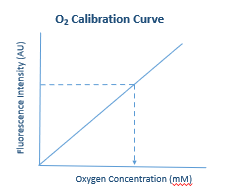
Delivery Methodology: Gene gun
originally to deliver DNA into cells, but can also be used for PEBBLEs.
blast of helium shoots dried PEBBLEs off a disk, are propelled down into the cell culture dish and embedded randomly
Gene gun forces nanosensors through the cell membrane
Nanosensors also breach the nuclear membrane – possible trigger of cell death
Not ‘passive observation’
Delivery Methodology: Cellular internalisation of nanosensors
For phagocytic cells such as macrophages and glial cells
Sensors ingested via routine cell process
Remain encapsulated within phagosome
Nanosensors are not free in cell cytoplasm
initially used to detect free radicals
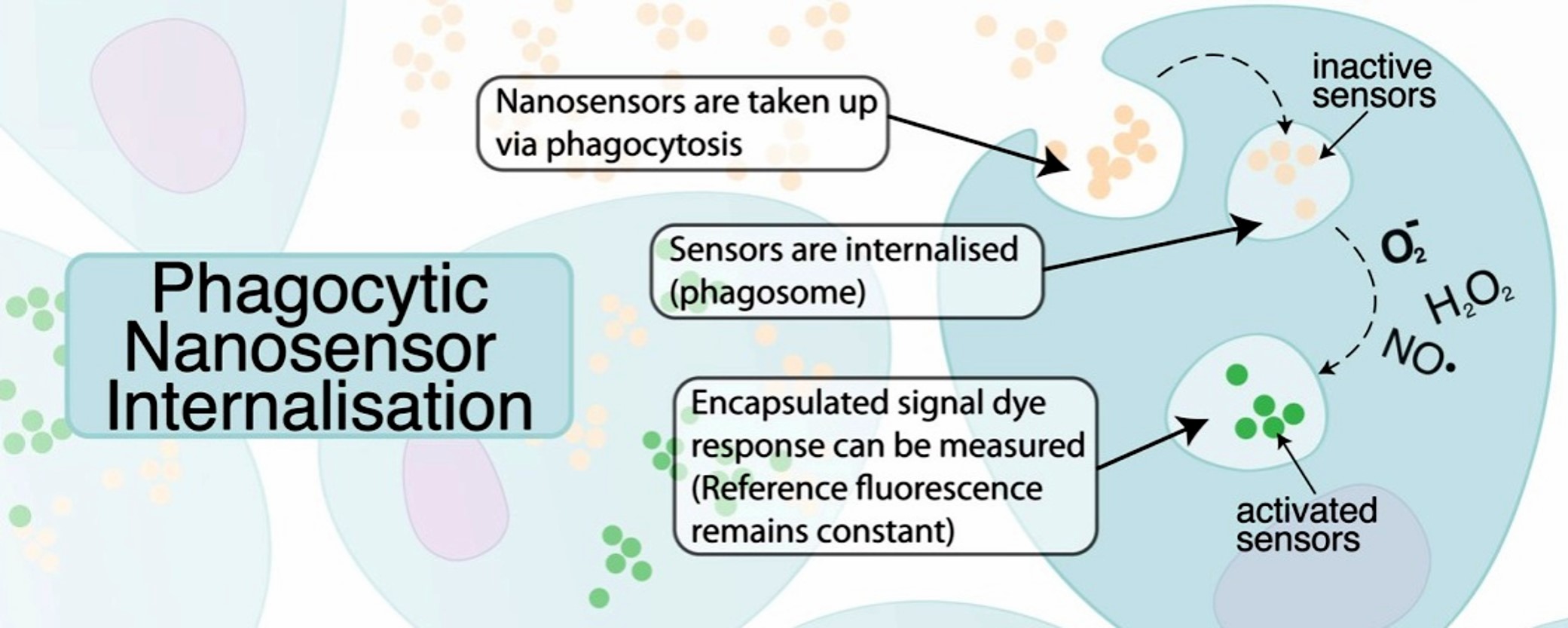
Delivery Methodology: liposomal transfection
for non-phagocytic cells (eg glioblastoma)
probably best
No natural endocytic pathways
Exploit transfection reagent for liposomal cargo delivery
Nanosensors are free within the cytoplasm
Check internalisation with confocal microscopy
minimal disruption of cellular processes
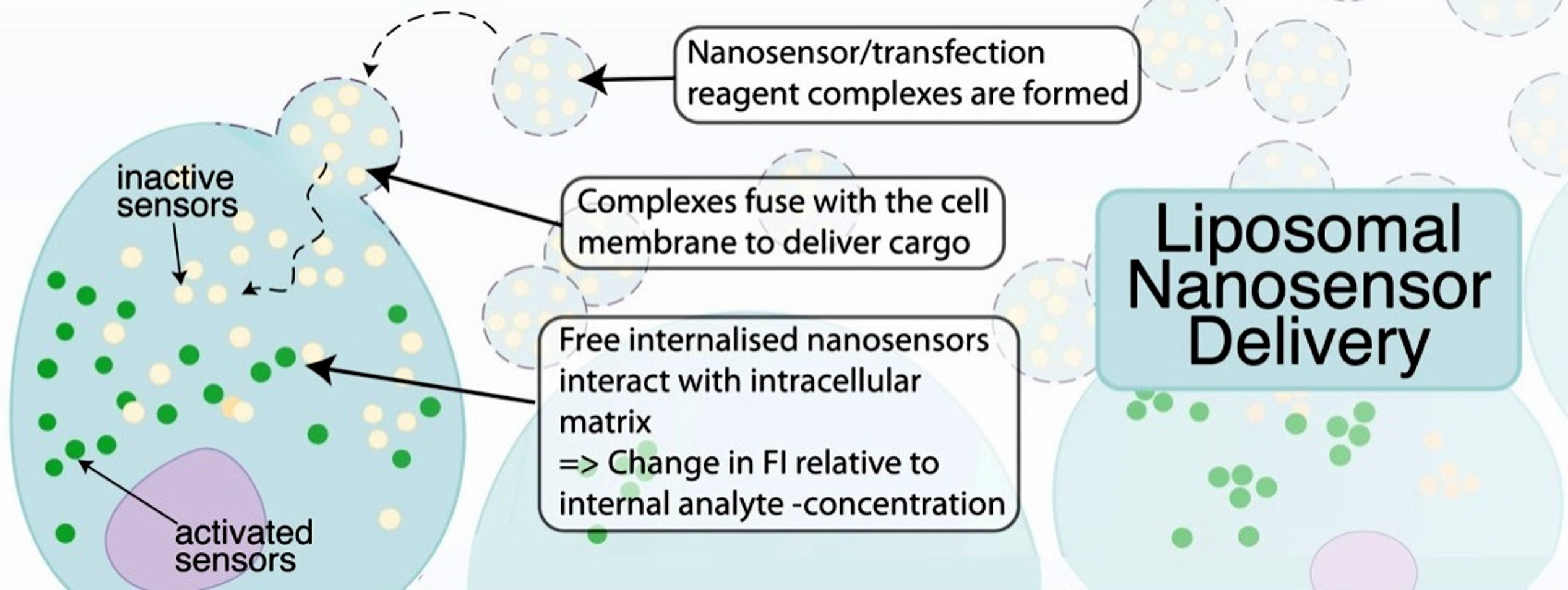
why is PEBBLE great?
Some nanotechnology production techniques require lots of time and expertise to accomplish.
In contrast, PEBBLE production is rooted in basic chemistry methods.
This technology is quite cheap, easy and fast.
How to make polyacrylamide PEBBLEs
Water in oil microemulsions are used for the radical mediated polymerisation
dissolve polymers in organic solvent
add fluorophore
evaporate solvent
The PEBBLEs are then concentrated
washed and vacuum filtered
The resulting powdered nanosensors can be stored indefinitely at RT before resuspension and use in sensor work
Surface Modification
involves polymerization of the PEBBLEs using a mixture of monomers, some having free amine groups
Some of these groups will be exposed on the outside of the PEBBLE, and simple attachment can be made to other molecules (like biotin) through carboxyl or succinimydal ester groups
can be used to attach Ab
The development and in vitro characterisation of an intracellular nanosensor responsive to reactive oxygen
Reactive oxygen species (O2-, NO and H2O2) play an important role in many pathological processes (eg stroke, arthritis, skin ageing)
Quantification of ROS is difficult due to their innate reactivity
Nano sensor technology could offer a unique insight into ROS-mediated intracellular events
Xanthine oxidase produces ROS
increase in enzyme = increase in fluorescence
NR8383 mouse alveolar macrophage cells
engulfed NP in phagosomes
overlaying images can identify leaks
stimulate free radical response
can measure free radical production in real time
Enhanced uptake of nanoparticle drug carriers via a thermoresponsive shell enhances cytotoxicity in a cancer cell line
standard chemotherapy drugs are predominatindly hydrophobic
need large doses= side effects
Tumours are slightly hyperthermic (+1–2 °C) compared to surrounding healthy tissue
Encapsulate drug in a ‘thermoresponsive vehicle’ to target the therapy to tissue at elevated temperature while leaving other tissues unaffected
Hyperthermic region can be defined by the application of external ultrasound, or by near-infra-red irradiation
outside capsule is temperature sensing hydrophobic polymer strands
increase temp to 40c > hydrophobic chains collapse > can be absorbed by tumour cell
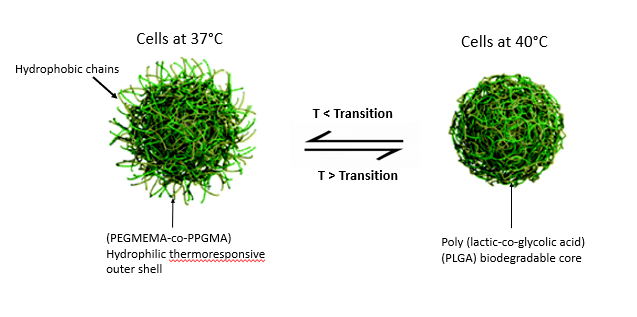
Cytotoxicity of Paclitaxel (PTX)-loaded nanoparticles in Breast Cancer (MCF-7) cells
Paclitaxel used to treat breast cancer
Cells were incubated with either free PTX or nanoparticles containing PTX at normal physiological (37 °C) or mildly hyperthermic (40 °C) temperature.
Cellular metabolic activity was determined using an MTT assay
Free PTX displayed the same effect on metabolic activity at both temperatures indicating that temperature variation over the 37–40 °C range did not affect uptake of the free drug or its inherent efficacy.
At 37 °C, nanoparticles containing PTX displayed toxicity comparable to, or lower than, that of free PTX – reduced nanoparticle uptake of PTX?
Conversely, at 40 °C toxicity of PTX nanoparticles was greater than that of free PTX most likely due to increased particle uptake and release of PTX within the cell.
Conjugated Polymer Nanoparticle (CPN®)
Excellent stability – 20 months, pH 2 – pH 10, up to 120°C
Unaffected by photobleaching in cells and samples
Non-toxic – heavy-metal free, organic
Contains iron oxide – for magnetic manipulation
VERY fluorescent
Fluorescence emission wavelengths from 420 nm to 1130 nm
Familiar surface ligand chemistry – for attaching targeting biomolecules (Ab, oligonucleotides, streptavidin, etc.)
Storage at ambient temperatures – unless linked to a biological molecule, then store at 4°C
Theranostic NIR-active conjugated polymer nanoparticles
Three conjugated polymer nanoparticles (CPNs) were developed using PTB7, a material commonly used in solar cells.
The CPNs show strong absorption and emission in the NIR-I window (650–950 nm), ideal for biological imaging.
NIR imaging capability was demonstrated in A549 human lung epithelial cells.
The CPNs generate reactive oxygen species (ROS) upon UV photoexcitation, confirmed in aqueous solutions and HaCaT cells.
This ROS generation leads to phototoxic effects, useful for therapeutic purposes.
PTB7’s dual functionality—NIR imaging and ROS production—makes it suitable for theranostic applications.
The system offers potential for photodynamic therapy (PDT), enabling both cancer detection and treatment.
PTB7’s prior use in solar energy and display technology stems from its NIR optical properties, which are also advantageous in biomedical applications.
Photodynamic Therapy (PDT)
PDT relies on a photo-induced generation of reactive oxygen species by a photosensitizer (PS)
Used clinically in the treatment of acne, precancerous cells and sun-damaged skin
PDT Advantages:
Minimal invasiveness or damage to healthy tissues
Lack of drug resistance
Applicable to a broad spectrum of cancer targets
can bind NP to specific Ab for tumour Ag, irradiate with light and cause free radical production to kill cell
Key Photosensitiser Properties
Biocompatible
Excellent ROS generation ability
Strong near-infrared (NIR) absorption
NIR = longer WL = will pass through skin to tumour
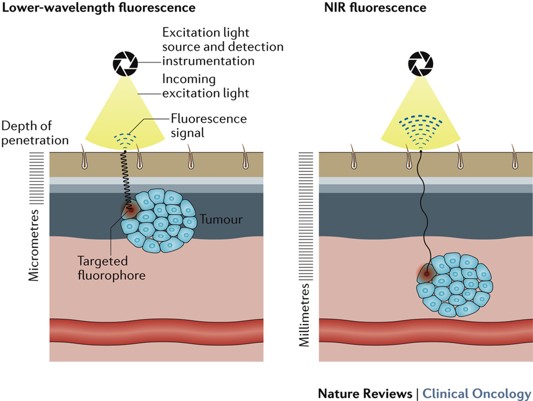
Production of CPNs using Nanoprecipitation
polymer strands in stir in pot of water with co polymer
CPNs co-precipitated with a copolymer
Optical properties of PTB7-based CPNs in aqueous solutions.
co-polymer effects maximum fluorescence
may be due to polymer degradation, how well does it withstand free radical reduction
CPN Dependent Superoxide production in response to photostimulation at 365nm
DTSSP on surface of gold electrode, banded to cytochrome c
Superoxide (O₂⁻) reducing the Fe³⁺ in cytochrome c to Fe²⁺
electron taken by +ve electrode surface
process repeated by present free radicals
